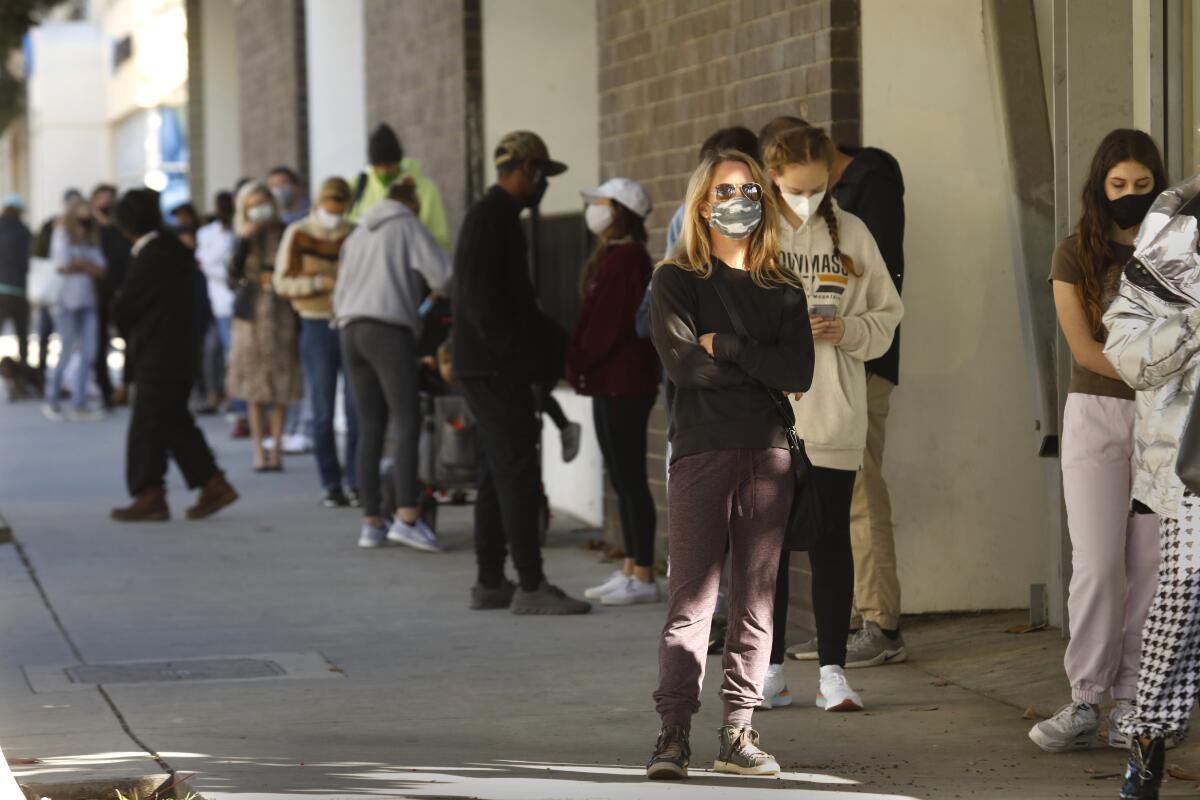Latinx Files: Essential workers, many of them Latinx, are back on the front lines as Omicron surges

- Share via
As coronavirus case numbers continue to skyrocket around the country, as long testing lines return, and as the calls and text messages from friends and family confirming positive tests start rolling in like it’s 2020, it bears repeating that it is the Latinx community that will once again bear the brunt of the latest variant.
We saw this happen in spring 2020. Latinx workers were tasked with keeping the economy going, exposing themselves to the virus that has been so devastating and brutal.
The Latinx experience chronicled
Get the Latinx Files newsletter for stories that capture the multitudes within our communities.
You may occasionally receive promotional content from the Los Angeles Times.
And the messaging from elected officials and health experts is seemingly putting the economy on the front burner in another replay of 2020.
For me, that feeling of deja vu began on Dec. 27, after Dr. Anthony Fauci, the White House top adviser on COVID-19, went on CNN to explain why the Centers for Disease Control and Prevention had reduced the number of isolation days for asymptomatic people infected with COVID-19 from five to 10. The guidelines also didn’t require asymptomatic people to get a negative coronavirus test after quarantining.
“If you are asymptomatic and you are infected, we want to get people back to the jobs, especially those with essential jobs,” he said. “They can get back to the workplace, doing things that are important to keep society running smoothly.”
Unsurprisingly, there was backlash. On Twitter, USC Professor Natalia Molina expressed what many of us were thinking.
“#CDC says ‘Sana sana colita de rana.’,” she tweeted.
I felt it once again after newly elected New York City Mayor Eric Adams pleaded with big businesses to reopen for the sake of those who didn’t have the option of working from home.
“If we don’t open our cities, that’s almost a million people who are behind in our rent right here in this city,” he said, making no mention of New York’s eviction moratorium expiring next week.
“My low-skilled workers, my cooks, my dishwashers, my messengers, my shoe-shine people, those who work at Dunkin’ Donuts — they don’t have the academic skills to sit in the corner office,” added Adams, a former police officer who spent decades in a department that doesn’t require a college degree to be hired.
Never mind that a recent report put out by the UCLA Labor Center found that fast-food workers faced increased health risks and labor violations during the pandemic.
“Fast-food workers have showed up every day of the COVID-19 pandemic, risking our lives to keep our stores open and our communities fed,” said Angelica Hernandez, a McDonald’s worker from Los Angeles.
“The companies we work for have called us essential, but this report shows they think we’re disposable and that they’ve decided keeping us in unsafe and unsanitary conditions is worth it for higher corporate profits. But we won’t be silent — my co-workers and I will continue to fight for better working conditions and a voice on the job, so that our families and our communities can feel safe and thrive.”
For all the efforts to keep the economy going, COVID-19 is still disrupting the way we live.
In Los Angeles, the healthcare system is facing staffing shortages because workers keep getting infected, and on Tuesday The Times reported that more than 1,000 police officers, firefighters and paramedics were ill or quarantined at home.
As we relive some of the worst parts of the early days of the pandemic, we can at least be thankful that this variant doesn’t appear to be as deadly as previous mutations.
But until we’re in the clear, rest assured that it’s our most vulnerable that will continue to suffer. After all, when given the choice of losing one’s livelihood or risk getting infected, the latter option will continue to win out, especially when the Biden administration has already made it clear it has no plans on providing financial relief.
Consider subscribing to the Los Angeles Times
Your support helps us deliver the news that matters most. Become a subscriber.
Q.E.P.D. Fusion, 2013-21
On Jan. 31, 2021, Univision finally pulled the plug on Fusion, the ill-fated network and digital platform launched in 2013 with ABC News that was originally aimed at catering to English-speaking Latinx millennials before executives shifted focus to appeal to all millennials.
Execs kept launching and pulling shows and talent. It was like they were throwing a bunch of spaghetti at a wall to see what would stick only to find nothing worked. There were a lot of questionable decisions about programming and management.
I would have personally gone with another word that starts with an “s” to describe what was being flung at the wall, but she’s not wrong. As a former employee, I can attest that Fusion was indeed a hot mess, and its dysfunction was chronicled on several occasions by Vanity Fair, Digiday and Jezebel, which was part of Fusion Media Group when that scathing report was published.
I’m hoping to write more about the rise (and mostly) fall of Fusion, so if you’re a former employee who would like to go on the record, you can hit me up at [email protected] or [email protected].
In the meantime, I leave you with this music video, the first thing that Fusion ever aired. I assure you, this is not a joke. It really did air. Thankfully, Fusion had so few viewers that it may as well not have happened.
Things we read this week that we think you should read
— Capital & Main has this report on how California legislators could use the state’s budget surplus to extend sick leave for workers out with COVID-19
— The Best Thing on the Latinternet: One of my favorite Twitter accounts is @UFWupdates, an account run by the United Farm Workers that advocates and champions the very people that feed us. On Tuesday, the account tweeted a challenge to anyone — te hablan, Eric Adams — who thinks there’s no skill involved in agricultural work.
— For Study Hall, Chantal Flores wrote about how journalists of color are often excluded from being part of investigative teams. For the sake of transparency, the Los Angeles Times has 10 reporters and editors on its investigative team, only three who are people of color. Additionally, my colleagues and fellow Times Latino Caucus members Paloma Esquivel and Robert Lopez do investigative work, but aren’t technically part of that team. If my bosses are reading, I’d like to ask them a question popularized by the great Diondre Cole: What up with that?
— Did you make a New Year’s resolution to live and eat healthier? If so, interim food editor Daniel Hernandez has this recipe for jugo verde to keep you on track. I hear it’s also great for hangovers.
— The homies over at L.A. Taco (sup foos!) wrote about Blossom Market, a new food hall in San Gabriel that highlights the cuisines of the Latinx and Asian communities.
— If you’re reading this, we want to hear from you! One of the recurring sections I’d like to bring back is the “Meet Our Readers” segment. I want to hear from you! If you’d like to be featured, send me an email at [email protected].
The Latinx experience chronicled
Get the Latinx Files newsletter for stories that capture the multitudes within our communities.
You may occasionally receive promotional content from the Los Angeles Times.




